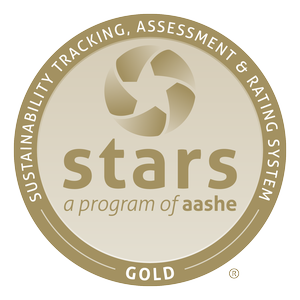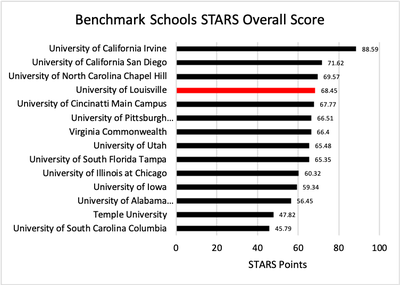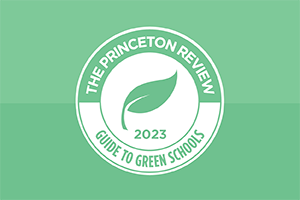Annual Reports
Annual UofL Sustainability Reports
2022 Sustainability Milestones for UofL
- In January, the Council launched a new annual Sustainability Literacy & Culture Assessment, incollaboration with student interns and Institutional Research who developed, pre-tested (summer 2021) and fully launched an annual assessment of a representative sample of the entire UofL community. In 2022, the survey was sent to a total of 5,971 faculty, staff, and students.
- T
 hroughout February & March, we challenged students, faculty, and staff to take action for sustainability through another successful Ecolympics, combining an energy-conservation competition among the residence halls with the university-wide Campus Race to Zero Waste, and a new month-long E-waste recycling drive in partnership with UofL eSports Team. In the Diversion category, UofL had our best year ever, finishing #1 among large universities! Out of all 103 schools, UofL finished #8 in the nation, #1 in the ACC, and #1 in the state, with an overall Recycling Rate of 63.438%!
hroughout February & March, we challenged students, faculty, and staff to take action for sustainability through another successful Ecolympics, combining an energy-conservation competition among the residence halls with the university-wide Campus Race to Zero Waste, and a new month-long E-waste recycling drive in partnership with UofL eSports Team. In the Diversion category, UofL had our best year ever, finishing #1 among large universities! Out of all 103 schools, UofL finished #8 in the nation, #1 in the ACC, and #1 in the state, with an overall Recycling Rate of 63.438%!
-
In February, the Council continued its mentorship with Hanover College(Indiana) Environmental Stewardship Committee in establishing and developing a sustainability program. EcoReps Director, Dr. Brian Barnes, and Assistant to the Provost for Sustainability Initiatives
 , Dr. Justin Mog, returned to Hanover to continue consultation with Hanover students and members of the committee and to deliver a public lecture on environmental stewardship.
, Dr. Justin Mog, returned to Hanover to continue consultation with Hanover students and members of the committee and to deliver a public lecture on environmental stewardship.
- In March, UofL earned certification as a Silver-level Bicycle Friendly University 2021-2025. For the third time since 2013, the League of American Bicyclists certified that the University of Louisville is a Bicycle Friendly University at the Silver level.
- In April, UofL celebrated Arbor Day & our 12th consecutive year of Tree Campus Higher Education status with a collaborative tree-planting and giveaway to mark the 75th anniversary of UofL's Hite Institute of Art & Design.
- In May, UofL achieved a 2022 STARS Gold rating (68.45%), documenting a 2.21% improvement over our 2019 rating. UofL has consistently maintained the highest STARS rating of any school in Kentucky;
 we rank 4th among our official Benchmark Institutions and among our ACC competitors; and we remain in the top 100 most sustainable schools on the planet!
we rank 4th among our official Benchmark Institutions and among our ACC competitors; and we remain in the top 100 most sustainable schools on the planet! - In May, the Council submitted to UofL Leadership: a revised Climate Action Plan, UofL’s first-ever Sustainability Plan and Vision for Zero Waste, and a proposal for the establishment of an Office of Sustainability with multiple staff.
- In May, we organized with Get Healthy Now another successful Bike Month Challenge, with Team UofL pedaling almost 5,000 miles, and then in the fall, we shifted into even higher gear with a Cycle September in which Team UofL pedaled nearly 6,000 miles.
- From June – October, the Council supported the reopening of the Gray Street Farmers’ Market and in September,
 funded a new UofL Day at that Gray Street Farmers’ Market and organized Bike or Bus Trips to the Market for the Cards Commuter Challenge.
funded a new UofL Day at that Gray Street Farmers’ Market and organized Bike or Bus Trips to the Market for the Cards Commuter Challenge. - Throughout the summer, the Sustainability Council offered well-attended sustainability breakout sessions during all 13 Student Orientations and we welcomed new students with Zero Waste Orientation meals that diverted 93.8% of waste from the landfill.
- In August, the Council hosted the 13th annual Green Threads Faculty Workshop: Sustainability Across the Curriculum, after recruiting the largest Green Threads cohort in years, with ten participants from four Colleges and two Green Tapestries collaborative projects.
- In August, UofL faculty, including a Green Threads alum, were awarded funding to investigate Environmental Health Literacy and Justice in and around Rubbertown.
-
 In September, we organized another successful Cards Commuter Challenge, with participants logging over 10,000 car-free miles.
In September, we organized another successful Cards Commuter Challenge, with participants logging over 10,000 car-free miles. - In October, UofL participated in the inaugural city-wide Louisville Tree Week with campus events, and our tree care was given a national platform as we shared our work in the Arbor Day Foundation's Urban Forestry webinar series on Building a Resilient Canopy.
- In October, the Council hosted its 13th annual Sustainability Week, including the 15th annual Campus Sustainability Day Fair.
- In October, we celebrated the opening of the new Myers Medical Lofts at HSC, an historic preservation project saving the 122-year-old UofL School of Dentistry from demolition & contributing to dense, walkable downtown livability.
- In October, with funding from Canon, and labor of Sustainability Council interns, UofL Dining began production in a new microfarm at the Ville Grill, offering the freshest possible ingredients for meals.
- In October, UofL co-hosted the 6th annual Environmental Justice Conference with speakers from across the university and community.
- In November, UofL was recognized by the Post-Landfill Action Network for being in the Top 10 Zero Waste Campuses.
-
 In November, we celebrated UofL again being highlighted in The Princeton Review Guide to Green Colleges.
In November, we celebrated UofL again being highlighted in The Princeton Review Guide to Green Colleges. - With funding from Kroger’s Zero Hunger | Zero Waste initiative, the UofL Free Store enhanced its new SAC location with a door wrap and feather flags, expanded its operating hours to M-Th 12-6pm throughout the fall, continued monthly Free Sale events in the Red Barn, and was profiled by Spectrum News in December.
- Building on our long-standing partnership, in 2022, UofL collaborated with Louisville Water Co. to promote tap over bottled water in the BAB and at campus events such as the Campus Sustainability Day Fair.
- Throughout 2022, the Garden Commons and Urban & Public Affairs Garden offered weekly workdays and monthly workshops to connect the campus community to the land and fresh, healthy food.
- Throughout 2022, the UofL Community Composting Project offered weekly workdays to divert tons of food waste from the landfill and generate rich organic soil for our gardens, while supporting the spin-off Louisville Compost Co-op and associated urban agriculture projects on-site, including a new campus apiary and beekeeping internship, a new aquaponics system, a new renewable energy internship, and vermicomposting operations, making our first compost tea.
- Throughout 2022, we offered professional development and engagement opportunities to dozens of students through ourpaid internship program, with positions in Zero Waste, Bike Mechanics, HSC Green Team, Sustainability Communication, Vermicomposting, Sustainable Dining, STARS Sustainability Assessment, Carbon Accounting, EcoReps, Composting, Garden, Beekeeping, Renewable Energy Systems, and the Free Store.
- Throughout 2022, the EcoReps Program offered leadership, training, and service opportunities to students, faculty, and staff, with monthly lunch & learn workshops.
- Throughout 2022, the Sustainability Roundtable connected researchers and practitioners across disciplines to exchange ideas and facilitate collaboration.
UofL Sustainability Annual Reports
- UofL Sustainability Council 2022 Report
- UofL Sustainability Council 2020-2021 Report
- UofL Sustainability Council FY 2017-2018 Report
- UofL Sustainability Council FY 2016-2017 Report
- UofL Sustainability Council FY 2014-2015 Report
- UofL Sustainability Council FY 2013-2014 Report
- UofL Sustainability Council FY 2012-2013 Report
- UofL Sustainability Council FY 2011-2012 Report
- UofL Sustainability Council FY 2010-2011 Report
- UofL Sustainability Council FY 2009-2010 Report
- UofL Sustainability Council 2008 Annual Report
Other UofL Sustainability Reports
Greenhouse Gas Emissions
In line with our Carbon Commitment to reduce greenhouse gas emissions down to net zero by 2050, UofL tracks the carbon pollution we are responsible for on an annual basis and publicly shares our annual Greenhouse Gas Emissions Reports online here.
STARS
- Since our inception, the UofL Sustainability Council has been structured around the Sustainability Tracking, Assessment & Rating System developed by AASHE (the Association for the Advancement of Sustainability in Higher Education) and use it as the primary tool to measure our progress and engage in strategic planning.
- UofL was a Charter Participant in STARS, having submitted our first STARS report in January 2011, the 10th school in the world to do so. Since then, we have submitted a new STARS report roughly every three years, and continue to improve our score each year as we push toward Platinum.
- Access all of our STARS Reports online here.
Other Ratings & Rankings
- UofL also regularly reports to a variety of organizations for other sustainability ratings and rankings. Find them all online here.



